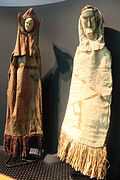Brazilian art

Brazil was colonized by Portugal in the middle of the 16th century. In those early times, owing to the primitive state of pre-Portuguese civilization there, not much could be done in regard to art expression. The original inhabitants of the land, pre-Columbian Indian peoples, most likely produced various forms of art, but very little is known about this. Little remains, except from specific cultures like the Marajoara, who left sophisticated painted pottery. So, Brazilian art—in the context of Western Art—began in the late 16th century and, for the greater part of its evolution, depended wholly on European standards.
Pre-Columbian traditions
The oldest known art in Brazil is the cave paintings in Serra da Capivara National Park in the state of Piauí,[1] dating back to c. 13,000 BC. More recent examples have been found in Minas Gerais and Goiás, showing geometric patterns and animal forms.[2]
One of the most sophisticated kinds of Pre-Columbian artifact found in Brazil is the sophisticated Marajoara pottery (c. 800–1400 AD), from cultures flourishing on Marajó Island and around the region of Santarém, decorated with painting and complex human and animal reliefs. Statuettes and cult objects, such as the small carved-stone amulets called muiraquitãs, also belong to these cultures.[3] The Mina and Periperi cultures, from Maranhão and Bahia, produced interesting though simpler pottery and statuettes.
In the beginning of the 21st century, the ancient Indian traditions of body painting, pottery, cult statuettes, and feather art are still being cultivated by the remaining Indian peoples.
-
Cave paintings, Serra da Capivara National Park.
-

Shark-shaped carved stone, Sambaqui culture, Museu da Universidade Federal do Rio Grande do Sul.
-
Burial urn, Marajoara culture. American Museum of Natural History.
-
Santarém culture. Museu Paraense Emílio Goeldi.
-

Bororo Indian with feather headdress and body painting.
-
Tikuna ceremonial dresses. Memorial dos Povos Indígenas.
-
Tiriyó-kaxuyana beadwork. Memorial dos Povos Indígenas.
-
Enawene-nawe body-art.
Baroque
The first Western artists active in Brazil were Roman Catholic priests who came from Portugal to “civilize” the Indians. Jesuits assumed an important role in this process, with their many missionary establishments called "Reductions" teaching religion through art in the form of sacred plays, music, statuary, and painting. José de Anchieta was the first important playwright; Agostinho de Jesus and Agostinho da Piedade produced the first known sculptures; Belchior Paulo, João Felipe Bettendorff, Ricardo do Pilar, and a few others did the first paintings; while Francisco de Vaccas and Pedro da Fonseca started organizing the musical life of the infant colony. Basílio da Gama and Gregório de Mattos were the first secular poets. All of them worked under the influence of the Baroque, the dominant style in Brazil until the early 19th century.[4][5]
Through the 17th and 18th centuries Baroque art flourished with increasing richness and craftsmanship, mainly in Bahia and Pernambuco along the coast and in some inland regions, reaching the highest levels of originality in Minas Gerais, where a gold rush nurtured a rich and cultured local society. In Minas lived the greatest artists of Brazilian Baroque: painter Manuel da Costa Ataíde and sculptor-architect Aleijadinho. Minas was also the birthplace of a proto-Neoclassical school of music and literature, with composers Lobo de Mesquita and Francisco Gomes da Rocha, and poets Tomás Antônio Gonzaga and Cláudio Manuel da Costa.[5][6]
-

José Joaquim da Rocha: Painted ceiling of St. Dominicus Church, Salvador
-

Ricardo do Pilar: Man of sorrows, c. 1690
-

São Francisco Church, Salvador
-

João Nepomuceno Correia e Castro: Immaculate Conception. Museu da Inconfidência
-

School of Bahia: Christ the Savior.
-
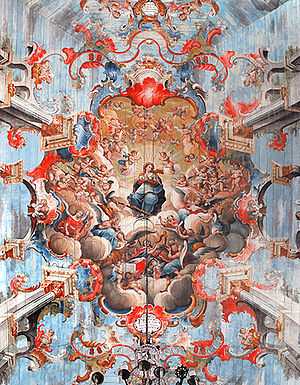
Ataíde: Our Lady surrounded by musician angels, Church of Saint Francis of Assisi, Ouro Preto
-
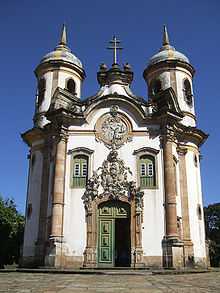
Aleijadinho and Francisco de Lima Cerqueira: Church of Saint Francis of Assisi, Ouro Preto
-

Aleijadinho: Christ praying, Bom Jesus de Matosinhos Sanctuary
19th century: Neoclassicism, Romanticism, Realism
One single event in the 19th century sowed the seeds for a complete renewal in Brazilian visual arts: the arrival of the French Artistic Mission in 1816, which strongly reinforced the Neoclassical style, previously seen in Brazil only in timid attempts. Joachim Lebreton, its leader, proposed the creation of an Academy of Fine Arts, later restructured as the Imperial Academy of Fine Arts. The Academy was the most important center for the visual arts through nearly the whole of the 19th century. It imposed a new concept of artistic education and was the basis for a revolution in Brazilian painting, sculpture, architecture, graphic arts, and crafts.[7] A few decades later, under the personal patronage of Emperor Pedro II, who was engaged in an ambitious national project of modernization, the Academy reached its golden age, fostering the emergence of the first generation of Romantic painters. Victor Meirelles and Pedro Américo, among others, produced lasting visual symbols of national identity. It must be said that in Brazil Romanticism in painting took a peculiar shape, not showing the overwhelming dramaticism, fantasy, violence, or interest in death and the bizarre commonly seen in the European version, and because of its academic and palatial nature all excesses were eschewed.[8][9][10]

Meanwhile, literature too evolved towards a romantic-nationalist school with the works of Casimiro de Abreu and Manuel Antônio de Almeida. Around 1850, a transition began, centered upon Álvares de Azevedo, who was influenced by the poetry of Lord Byron. This second generation of Romantics was obsessed with morbidness and death, and soon after, social commentary could be found in literature, both features not seen in the visual arts. Antônio Castro Alves wrote of the horrors of slavery, and the persecuted Indians were rescued through art by poets and novelists like Antônio Gonçalves Dias and José de Alencar. These trends combined in one of the most important accomplishments of the Romantic era in Brazil: the establishment of a Brazilian national identity based on Indian ancestry and the rich natural environment of the country.[11]
In music, the 19th century produced only two composers of outstanding talent: neoclassical sacred composer José Maurício Nunes Garcia, for a while music director to the court, and later, Romantic operist Carlos Gomes, the first Brazilian musician to win international acclaim.[12]
In the late 19th century, Brazilian art became acquainted with Realism. Descriptions of nature and of the people of Brazil's varied regions as well as psychological romances proliferated with João Simões Lopes Neto, Aluísio Azevedo, Euclides da Cunha, and, above all, Machado de Assis, while Almeida Junior, Pedro Weingärtner, Oscar Pereira da Silva, and other Realist painters depicted folk types and the distinctive colors and light of Brazilian landscape.
-

Simplício de Sá: Portrait of Peter I, ca. 1830. Imperial Museum
-

São Cristóvão, Rio de Janeiro
-

Theatro da Paz, Belém do Pará
-

Victor Meirelles: The first Mass in Brazil, 1861. Museu Nacional de Belas Artes
-

Rodolpho Bernardelli: Christ and the adulterous woman, 1881
-
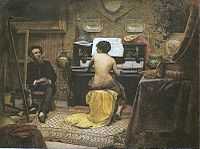
Almeida Junior: Model's rest, 1882. Museu Nacional de Belas Artes
-

Nicola Facchinetti: Rodrigo de Freitas lagoon, ca. 1884
-

Belmiro de Almeida: Effects of sunlight, 1893
20th century: Modern and Contemporary
The beginning of the 20th century saw a struggle between old schools and modernist trends. The Week of Modern Art festival, held in São Paulo in 1922, was received with fiery criticism by conservative sectors of the society, but it was a landmark in the history of Brazilian art. It included plastic arts exhibitions, lectures, concerts, and the reading of poems. Due to the radicalism (for the times) of some of their poems and music, the artists were vigorously booed and pelted by the audience, and the press and art critics in general were strong in their condemnation. However, those artists are now seen as the founders of Modern art in Brazil. Modernist literature and theory of art were represented by Oswald de Andrade, Sérgio Milliet, Menotti del Picchia, and Mário de Andrade, whose revolutionary novel Macunaíma (1928) is one of the founding texts of Brazilian Modernism. Painting was represented by Anita Malfatti, Tarsila do Amaral, Emiliano Di Cavalcanti, Vicente do Rego Monteiro; sculpture by Victor Brecheret; and music by Heitor Villa-Lobos, the leader of a new musical nationalism, among many others.[13]

The Week not only introduced to a wider public modern, experimental tendencies derived from European Expressionism, Cubism, and Surrealism, but also wanted to make use of national folklore as a basis for an art more relevant to the Brazilian reality, with an enhanced social awareness. However, the radicalism of those first Modernists couldn't last for long in a society used to traditional fashions, and the original core members had separated by 1929, pursuing individual paths. What Brazilian art then became was a mix of some important achievements of the Moderns, meaning freedom from the strict academic agenda, with more conventional traits, giving birth in the following generation to a moderate Modernism, best exemplified by painter Cândido Portinari, who was something like the official painter of the Brazilian government in mid-century.[14]
The erosion of radical Modernism in the visual arts in the early 20th century was not reflected in Brazilian literature. Clarice Lispector wrote existentialist novels and developed a highly personal style, filled with stream-of-consciousness and epiphanies. João Guimarães Rosa changed the face of Brazilian literature with his experimental language, and playwright Nelson Rodrigues dealt with crime, prejudice, passion, and sexual pathologies. In the 1950s, painting and sculpture regained strength through Abstractionism, and architecture began also to display advanced features, influenced by Le Corbusier. Its greatest achievement was the urban core of Brasília, designed by urbanist Lúcio Costa and architect Oscar Niemeyer, now a World Heritage Site.[15] Contemporary art in Brazil evolved from Modernism and assimilated later trends, focusing mainly in the early 21st century on city life and all its aspects and displaying a huge diversity of styles in tune with the growing internationalistic tendencies.
Contemporary Photography
Brazilian contemporary photography is one of the most creative in Latin America, growing an international prominence each year with exhibitions and publications. Names like Miguel Rio Branco, Vik Muniz, Sebastião Salgado, Guy Veloso, and others, get strong.
-

Ismael Nery: Nude woman crouching
-

Cândido Portinari: Study for Discovery of the Land mural at the United States Library of Congress.
-

Glênio Bianchetti: Bone game, 1955. Rio Grande do Sul Museum of Art
-
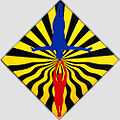
Milton Kurtz: Quasi contacto, 1989. Rio Grande do Sul Museum of Art
-
Victor Brecheret: Tomb of Olívia Guedes Penteado, São Paulo
-

Theorem, by Bruno Giorgi
-

Sculptures by Franz Krajcberg
-

Vasco Prado: Model resting, 1999. Rio Grande do Sul Museum of Art
-

Theatro Municipal, Rio de Janeiro. Eclectic
-

Lina Bo Bardi: São Paulo Museum of Art. Modern
-

Ruy Ohtake: Brasilia Shopping. Contemporary
See also
| Wikimedia Commons has media related to Art of Brazil. |
| Part of a series on the |
| Culture of Brazil |
|---|
 |
| History |
| People |
| Languages |
| Cuisine |
| Religion |
| Art |
| Literature |
|
Music and performing arts |
|
Media |
| Sport |
|
Monuments
|
|
Symbols |
|
- Latin American art
- Brazilian painting
- Brazilian sculpture
- Brazilian literature
- Brazilian architecture
- Brazilian music
References
- ↑ Almanaque Abril 2007. São Paulo: Editora Abril, 2007, p. 234.
- ↑ Martins, Simone B. & Imbroisi, Margaret H. História da Arte, 1988
- ↑ Correa, Conceição Gentil. Estatuetas de cerâmica na cultura Santarém. Belém: Museu Paraense Emílio Goeldi, 1965.
- ↑ KARNAL, Leandro. Teatro da Fé: Formas de Representação Religiosa no Brasil e no México do Século XVI. São Paulo, Editora Hucitec, 1998.
- ↑ 5.0 5.1 The Brazilian Baroque. Encyclopaedia Itaú Cultural
- ↑ MARIZ, Vasco. História da Música no Brasil: A música no tempo do Brasil Colônia. Rio de Janeiro: Nova Fronteira, 2005. pp. 33-46
- ↑ CONDURU, Roberto. Araras Gregas. In: 19&20 - A revista eletrônica de DezenoveVinte. Volume III, n. 2, abril de 2008
- ↑ BISCARDI, Afrânio & ROCHA, Frederico Almeida. O Mecenato Artístico de D. Pedro II e o Projeto Imperial. In: 19&20 - A revista eletrônica de DezenoveVinte. Volume I, n. 1, maio de 2006
- ↑ CARDOSO, Rafael. A Academia Imperial de Belas Artes e o Ensino Técnico. In: 19&20 - A revista eletrônica de DezenoveVinte. Volume III, n. 1, janeiro de 2008
- ↑ FERNANDES, Cybele V. F. A construção simbólica da nação: A pintura e a escultura nas Exposições Gerais da Academia Imperial das Belas Artes. In: 19&20 - A revista eletrônica de DezenoveVinte. Volume II, n. 4, outubro de 2007
- ↑ O Indianismo como Projeto de Nacionalidade. Secretaria Municipal de Educação - Prefeitura da Cidade do Rio de Janeiro
- ↑ A Música na Corte de D. João VI e D. Pedro I; Antonio Carlos Gomes. In MARIZ, Vasco. História da Música no Brasil. Rio de Janeiro: Nova Fronteira, 2005.pp 52-61; 76-95
- ↑ Semana da Arte Moderna. Pitoresco Website
- ↑ Modernism in Brazil. Encyclopedia Itaú Cultural
- ↑ Niemeyer, Oscar. Encyclopedia Itaú Cultural
| ||||||||
| ||||||||||||||||||||||||||||||||||||



